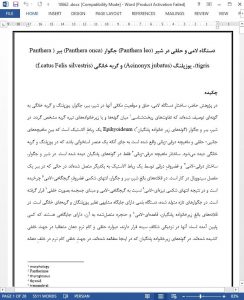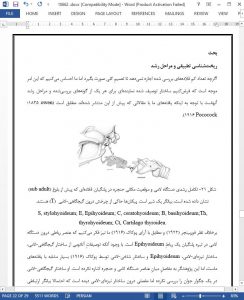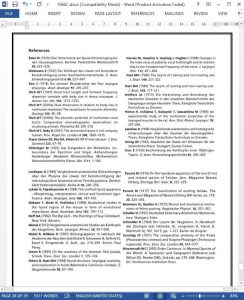Abstract
Structures of the hyoid apparatus, the pharynx and their topographical positions in the lion, tiger, jaguar, cheetah and domestic cat were described in order to determine morphological differences between species or subfamilies of the Felidae. In the lion, tiger and jaguar (species of the subfamily Pantherinae) the Epihyoideum is an elastic ligament lying between the lateral pharyngeal muscles and the Musculus (M.) thyroglossus rather than a bony element like in the cheetah or the domestic cat. The M. thyroglossus was only present in the species of the Pantherinae studied. In the lion and the jaguar the Thyrohyoideum and the thyroid cartilage are connected by an elastic ligament, whereas in the tiger there is a synovial articulation. In adult individuals of the lion, tiger and jaguar the ventral end of the tympanohyal cartilage is rotated and therefore the ventral end of the attached Stylohyoideum lies caudal to the Tympanohyoideum and the cranial base. In newborn jaguars the Apparatus hyoideus shows a similar topographical position as in adult cheetahs or domestic cats. In adult Pantherinae, the Basihyoideum and the attached larynx occupy a descended position: they are situated near the cranial thoracic aperture, the pharyngeal wall and the soft palate are caudally elongated accordingly. In the Pantherinae examined the caudal end of the soft palate lies dorsal to the glottis. Differences in these morphological features between the subfamilies of the Felidae have an influence on specific structural characters of their vocalizations.
Introduction
The tetrapod hyoid apparatus provides the skeletal scaffolding supporting the tongue, upper vocal tract and larynx, and thus forms the core of the vocal production system. Hyoid anatomy in mammals is very consistent in broad overview, with the number and general shape of segments, and the muscles connecting them, being highly conserved in mammalian evolution. Conceptually these segments can be broken into two divisions (see Fig. 1): the base portion (ceratohyoid, basihyoid and thyrohyoid) which provides a bony support for the tongue rostrally and larynx caudally, and a linkage portion which links the base to the skull (tympanohyoid, stylohyoid and epihyoid). The hyoid apparatus of mammals can vary in the extent to which its constituent parts are ossified, cartilagineous or ligamentous. This variation can occur among different species of the same order (e.g. Rodents, Primates) or family (e.g. Felidae [Carnivora]) and even within the same species such as humans (Fürbringer, 1922; Lykaki & Papadopoulos, 1988; Nakano et al. 1988).
Topographical position of the larynx and vocalization
The anatomical findings presented here on the relative topographical position of the larynx in the Felidae and its descent during ontogeny in some species have important implications for vocal tract length and hence specific structural characters of the species’ vocalizations (Fitch, 1997, 2000a, 2000b, Fitch & Reby, 2001). Ever since Owen (1835) it has been postulated that there is a correlation between the degree of ossification of the hyoid bones in this carnivore family and the presence or absence, respectively, of purring and roaring in its various species, the species with a fully ossified hyoid (subfamilies Felinae and Acinonychinae) being able to purr but not to roar and the only five felid species with a partly ligamentous hyoid (subfamily Pantherinae: lion, leopard, jaguar, tiger, snow leopard) being able to roar but not to purr. Peters & Hast (1994) discussed this hypothesis in some detail and concluded that no such specific correlation can be substantiated based on the data available then. On the other hand they argued that ‘… a hyoid with an elastic ligament instead of a bony epihyoid … allows for an elongation of the supraglottal vocal tract, i.e. the distance of the sound generator from the mouth, which results in lower pitch of calls’. This conclusion is incorrect as such an elongation does not result in a lowering of the pitch (which is determined by the call's fundamental frequency) but a lowering of its formant frequencies (Fitch, 1997, 2000a, 2000b, Fitch & Reby, 2001).











